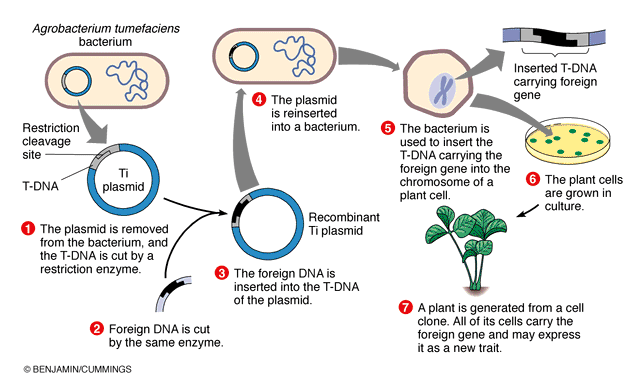Which Organism Is Most Commonly Used in Genetic Engineering
Restriction enzymes recognize and cut specific. EColi has been extensively used as work horse for genetic engineering eg production of humulin somatotropin.

What Are Genetically Modified Organisms Gmos Uvm Food Feed
The bacterium Escherichia coli is widely used in genetic engineering experiments as.
. The first major discovery. 1 The plasmid is inserted into a container containing restriction enzymes. To defend themselves from viruses bacteria evolved molecular scissors called restriction enzymes.
Most recombinant DNA technology involves the insertion of foreign genes into the plasmids small rings of DNA of common laboratory strains of bacteria. Artificial gene manipulation is known as genetic engineering. The process of manipulating DNA to make changes in a living organism.
It s the late 1960s. Some of these modifications have resulted in extending the host range of the bacterium to economically important crop species. What type of organism was the first to be successfully modified via the techniques of genetic engineering.
Coli is one of the most thoroughly studied of all living things. Up to 24 cash back This method is the most commonly used method in genetic engineering. A technique used to separate pieces of DNA based on the size of the DNA.
The microorganism Escherichia coli Ecoli has a long history in the biotechnology industry and is still the microorganism of choice for most gene cloning experiments. Since the initial reports in the early 1980s using Agrobacterium to. I Human insulin chains α and β chains are synthesized within the E.
This is accomplished by manipulating certain characteristics in the host organisms genetic material to make it more resistant disease or by. In 1973 scientists Herbert Boyer and Stanley Cohen used a. Genetic engineering GE is normally used for situations when a slight genetic change can produce a given advantage.
A common bacteria used in genetic engineering. However only in the past two decades has the ability of Agrobacterium to transfer DNA to plant cells been harnessed for the purposes of plant genetic engineering. The Baterium that is most commonly used in genetic engineering is a.
Somewhere between the summer of love and the last moon landing scientists discovered something extraordinary about bacteria. Restriction enzymes cut up the plasmids into small pieces. Since the initial reports in the early 1980s using Agrobacterium to generate transgenic plants scientists have attempted to improve this natural genetic engineer for biotechnology purposes.
The Baterium that is most commonly used in genetic engineering is - Sarthaks eConnect Largest Online Education Community. Agrobacterium tumefaciens and related Agrobacterium species have been known as plant pathogens since the beginning of the 20th century. Correct option is B Till today the most important in genetic engineering of plants has been the Ti plasmid of soil bacterium Agrobacterium tumefaciens.
For example genetic engineering is used in medical research to help combat disease. Ii Hormone somatostatin is also produced within the. This method uses small circular pieces of a DNA molecule called plasmids.
This method is mainly used for altering microorganisms such as bacteria.

Microbes And The Tools Of Genetic Engineering Microbiology

Site Currently Unavailable Plant Breeding Genetics Genetic Engineering
10 1 Cloning And Genetic Engineering Concepts Of Biology 1st Canadian Edition


Comments
Post a Comment